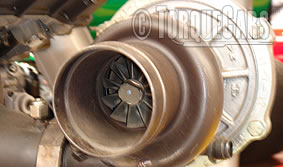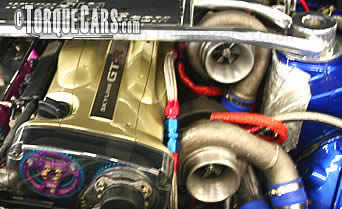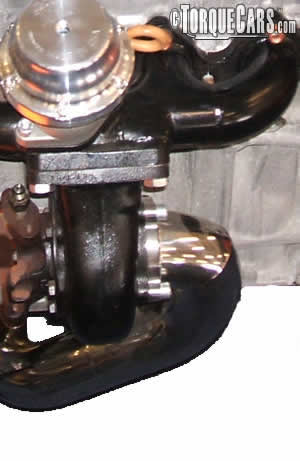Fitting an aftermarket turbo kit to a car.
"Charging ahead"
In all the movies and video games adding a turbo to a car makes a massive hike to a cars power. In reality this is quite a complex mod with many pitfalls so we will discuss it in detail here.
 If you are forcing more air into an engine you are increasing its volumetric efficiency (the efficiency of the engine at drawing in air). Forced induction is the most effective method of upping compression.
If you are forcing more air into an engine you are increasing its volumetric efficiency (the efficiency of the engine at drawing in air). Forced induction is the most effective method of upping compression.
All turbos and compressors will restrict an air intake but they will still pull through enough air to overcome that restriction. Low down the rev range you'll have a bit
Bear the following points in mind when adding a turbo to a non turbo car (NASP or naturally aspirated engine).
If you are still serious about adding a turbo, after reading this article, we suggest you join our friendly forum and get some specific tips and advice for your car model.
An average Naturally Aspirated engine pulls in around 60% of its volume, so is only 60% volumetrically efficient.
Highly tuned engines are more efficient. A typical TorqueCars member will have already spend much time and effort tuning their NASP engines. Even with a large spend they will struggle to reach anything like 85% efficiency. The solution is to force the air/fuel mixture into the cylinders.
An average turbocharged engine typically runs from 110% to 150% volumetric efficiency - the more the merrier!
A 2.0 NASP motor effectively uses around 1200-1300cc of its capacity and produce something approaching 200bhp (based on the rule of thumb of100bhp per 1000cc). If you added a turbo a 2.0 will use much more of it's two litre capacity, producing more power. (This gives a 2.0 turbo engine an optimum power figure far in excess of 100bhp per cylinder with production cars approaching 300 bhp!)
A turbo charged 1.6 engine in an early Formula 1 application produced well over 1000bhp. Now we see highly tuned 2.0 litre turbo cars hitting 700bhp and more with relative ease thanks to stronger components and tighter engineering parameters.
If you increase the amount of air/fuel in the cylinders, then as a result you will increase the compression. If you are not careful you risk knock or pre-ignition, so most turbo engines have a lower compression ratio than a stock engine.
When adding a turbo to an engine which was not originally designed for a turbo there are some major complications to take into account.

Interestingly lower compression engines with a turbo will have less turbo lag.
The best turbos to add to a non turbo NASP engine are small units with low boost levels unless you are prepared to invest heavily in engine mods.
You could also fit a water injection kit to dampen the air charge and prevent detonation.
Unless you have a direct injection engine you'll need to aim for around a 7:1 compression ratio when adding a turbo.
Go over a 9:1 ratio and you'll have problems. It will also help to use the highest octane fuel that you can. Higher octane fuel resists engine knock.
With the right fuelling and timing maps we have seen people running 25psi of boost on a 10:1 compression ratio! We should add that the aftermarket ECU and fuelling mods were of a very high specification on this application.
If you can restrict the turbo boost pressure to 5-7psi (as opposed to 25-35psi), as well as use higher octane fuel you should be able to run a turbo on a standard engine with around the 9:1 compression ratio. You can read more about Octane and its effect on engine knock in our fuel octane article.
Direct injection first pioneered on Diesel engines is finding it's way into petrol engines. Because the fuel is inject later into the intake charge it reduces the temperature of the charge helping to resist premature ignition.
This is why FSi and Di turbo engines can run very high compression ratios. There are often carbon build up issues on these early Di petrol engines though.

Particular attention should be paid to fuelling. More air requires more fuel or you risk the danger of burning too lean. You also want to avoid overfuelling when the boost from the turbo drops as this can destroy the engine.
On most aftermarket turbo applications it is unlikely that the cars existing fuel delivery system will be able to deliver sufficient fuel so you will need to uprate the fuel pressure with a new pump and fuel pressure regulator, the injectors will also need uprating.
When adding a turbo, for maximum performance gains, you should also get the head flowed, increase the port size, fit bigger valves and go with a larger exhaust header and system as there will be a much larger volume of air flowing through the engine.
Fitting an adjustable boost controller will allow you to experiment on a rolling road while attached to diagnostic equipment to find the optimum boost pressure and timing advance.
Most turbo kits only contain the necessary parts to physically get the turbo onto the engine (ie: an exhaust header and the necessary intake plumbing to the air filter.) Mapping and timing mods must also be carried out.
The car computer will also need to take into account the new fuelling requirements of a turbo, especially with regard to throttle position and wastegate control and rapidly changing fuel requirements between on and off boost conditions.
We strongly recommend a good aftermarket ECU to allow you to create a custom map for your new turbocharged engine.
Turbos are expensive but will add the most power for your money. You should allow about 40 hours for fitting, you really do need to know what you are doing and will require the ability to create a custom ECU map.
Generally speaking though it will usually be easier to source a turbocharged engine and do a engine transplant to this than add a turbo to a NASP engine. Most manufacturers now have a turbo charged engine in their line up which would make a suitable donor for your project.
TorqueCars suggest that you join the friendly tuning forum and get some specific tips and advice for turbo charging your car model - we now have a dedicated turbo tuning forum.
Please Check out my YouTube channel, we're regularly adding new content...
PLEASE HELP: I NEED YOUR DONATIONS TO COVER THE COSTS OF RUNNING THIS SITE AND KEEP IT RUNNING. I do not charge you to access this website and it saves most TorqueCars readers $100's each year - but we are NON PROFIT and not even covering our costs. To keep us running PLEASE Donate here
If you liked this page please share it with your friends, drop a link to it in your favourite forum or use the bookmarking options to save it to your social media profile.
Feedback - What do You Think?
Please use our forums if you wish to ask a tuning question, and please note we do not sell parts or services, we are just an online magazine.
Help us improve, leave a suggestion or tip
Please watch this video and subscribe to my YouTube channel.
One Response to “How to install a turbo to a non turbo car.”

 Click to accept YouTube Cookies & Play.
Click to accept YouTube Cookies & Play.
I own a 2011 Nissan 370z
Live in Carlisle cumbria
Wanting to add a turbo to my
Car have you got any places in mind for me to go too.